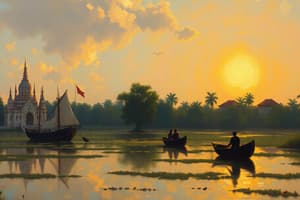Podcast
Questions and Answers
What materials were ancient buildings in Myanmar typically constructed from?
What materials were ancient buildings in Myanmar typically constructed from?
- Bamboo, wood, and stone
- Clay, hay, and granite
- Mud, palm leaves, and iron
- Brick, stucco, and teakwood (correct)
How did ancient Myanmar farmers clear land for cultivation?
How did ancient Myanmar farmers clear land for cultivation?
- Using advanced machinery
- By hiring professional land clearers
- Through slash-and-burn farming (correct)
- With chemical pesticides
What were the three main social classes in ancient Myanmar society?
What were the three main social classes in ancient Myanmar society?
- Scholars, priests, and merchants
- Farmers, traders, and craftsmen
- Rulers, warriors, and commoners (correct)
- Rulers, artists, and servants
How were marriages typically conducted in ancient Myanmar?
How were marriages typically conducted in ancient Myanmar?
What type of goods were exchanged in trade between ancient Myanmar and neighboring countries?
What type of goods were exchanged in trade between ancient Myanmar and neighboring countries?
What are some of the belief systems rooted in ancient Myanmar society?
What are some of the belief systems rooted in ancient Myanmar society?
When did Buddhism arrive in Myanmar?
When did Buddhism arrive in Myanmar?
What are some key features of Burmese Buddhism mentioned in the text?
What are some key features of Burmese Buddhism mentioned in the text?
Which religion quickly spread throughout Southeast Asia due to trade networks?
Which religion quickly spread throughout Southeast Asia due to trade networks?
What characterizes Myanmar's architectural heritage?
What characterizes Myanmar's architectural heritage?
Flashcards are hidden until you start studying
Study Notes
Ancient Myanmar Living: An Exploration of Cultural Practices and Daily Life
The ancient civilization of Myanmar, also known as Burma, is a fascinating study of human history and culture. Located in Southeast Asia, this region has been inhabited since prehistoric times, with evidence pointing to the existence of early human settlements dating back to around 57,000 years ago. Over time, Myanmar developed its own unique cultural practices and daily life routines that have shaped its people and their communities. This article will delve into these aspects, providing a glimpse into the rich history and culture of ancient Myanmar.
Cultural Practices
Religion
Ancient Myanmar society was deeply religious, with belief systems rooted in animism, ancestor worship, and Buddhism. The most prominent religion in Myanmar today, Buddhism arrived in the region around the 3rd century BCE and quickly spread throughout Southeast Asia due to trade networks. Some of the key features of Burmese Buddhism include the veneration of various relics associated with Buddha, such as his hair strands, and the use of totemic symbols called nats for protection and good fortune. These traditions are still practiced by many Myanmarese people today.
Architecture
Myanmar's architectural heritage is characterized by its intricate craftsmanship and striking visual appeal. Ancient structures like the Shwedagon Paya in Yangon showcase a blend of Mon-Khmer, Indian, and Chinese influences, reflecting the diverse cultural tapestry of the region. These buildings were typically constructed from brick, stucco, and teakwood, demonstrating not only the advanced knowledge of building techniques but also the artistic skills of the local craftsmen.
Daily Life
Agriculture and Trade
The economy of ancient Myanmar relied heavily on agriculture, particularly rice cultivation, which remains a staple food in contemporary Myanmar. Farmers used simple tools made from bamboo and wood, employing techniques like slash-and-burn farming to clear land for crops. Additionally, they traded with neighboring countries through established trade routes such as the Indian Ocean maritime network, exchanging goods like textiles, spices, and precious stones for other valuable resources.
Social Structure and Marriage Practices
Ancient Myanmar society was divided into three main social classes: rulers, warriors, and commoners. The monarchy held significant power over the people's lives, with kings often acting as both spiritual and temporal leaders. Marriages were typically arranged by families, and brides would move to their husbands' homes after the wedding ceremony, which usually involved the exchange of gifts between the two families. While much has changed since then, these practices have left lasting impacts on modern Burmese culture.
Conclusion
The ancient civilization of Myanmar offers a window into a rich tapestry of human culture and history. From religious beliefs to daily life routines, the complex web of connections between the land, its people, and their traditions has shaped Myanmar into the vibrant nation it is today. As we continue to learn more about this fascinating region, we can appreciate the enduring legacy left behind by those who came before us.
Studying That Suits You
Use AI to generate personalized quizzes and flashcards to suit your learning preferences.




